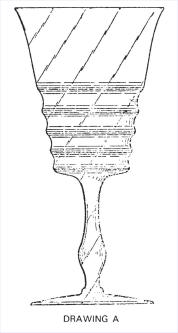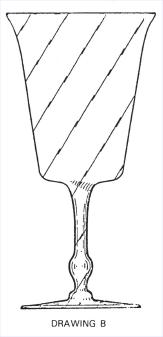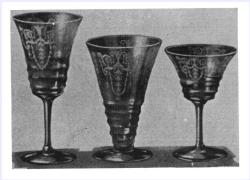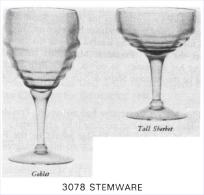No. 3077 Stemware
by Mark Nye
Issue No. 233 - September 1992
On November 19, 1925, W.C. McCartney, on behalf of the Cambridge
Glass Company, filed two design patent applications. The drawings
illustrating the designs that were a part
 of the application are shown
with this article and are labeled A and B. The United States Patent
Office, on February 9, 1926, issued Design Patent Nos. 69404 and 69405
to Cambridge, thus protecting the designs from direct copying by other
glass manufacturers.
of the application are shown
with this article and are labeled A and B. The United States Patent
Office, on February 9, 1926, issued Design Patent Nos. 69404 and 69405
to Cambridge, thus protecting the designs from direct copying by other
glass manufacturers.
Among the stemware lines offered in the 1927 Cambridge catalog was No. 3075 and its design is that shown in Drawing A. The diagonal lines in the drawings add perspective and are not part of the design. The actual stemware has fine vertical ribbing. The bowl shape of the No. 3075 line is that shown in the drawing and the pulled stem has the knob at its base. Each group of horizontal lines in the drawing represents a single horizontal rib in the actual stemware item. Some pieces of No. 3075 stemware, depending upon their size, may have fewer horizontal ribs than shown in the drawing.
No. 3075 stemware was apparently produced for only four years as it was not shown in the 1930 catalog or its supplements. It is known, however, that the line was still available in early 1929. Made in Amber, Bluebell, Emerald, Peach-Blo and perhaps other colors as well, No. 3075 is know to have been etched Imperial Hunt Scene and Nos. 704 and 731. It will also be found with D/805 (etched Imperial Hunt Scene Gold Encrusted).
 There is no known Cambridge stemware line with the bowl and stem
shape combination shown in Drawing B. Test marketing may have shown the
shape was not popular and because of this, or other unknown reasons, a
decision was made not to produce the line.
There is no known Cambridge stemware line with the bowl and stem
shape combination shown in Drawing B. Test marketing may have shown the
shape was not popular and because of this, or other unknown reasons, a
decision was made not to produce the line.
Sometime before the fall of 1928, the design in Drawing A was modified to remove the knob in the stem. The resulting stemware with a straight pulled stem became known as No. 3077. No. 3077 stemware is identical in shape and size to the No. 3075 but without the knob or bulge in the lower part of the stem. The other difference between the two lines is that No. 3077 has a wide vertical optic pattern compared to the fine optic pattern seen in No. 3075. Each line has its own style of non-stemmed, footed tumblers. The first reference found for No. 3077 stemware is a Cambridge catalog page that probably dates to Fall 1928. The following summer No. 3077 stemware appeared in a Cambridge advertisement placed in the July 8, 1929 issue of China, Glass & Lamps. This advertisement had the following caption: "GRACIOUS STEMWARE - Beautiful transparent colors with attractive shapes and cool etched decorations make Cambridge stemware rapid sellers. Shown is the No. 3077 design, decorated with the Cleo etching. The goblet is 9 ounce, the ice tea is 12 ounce and the tall sherbet is 6 ounce. To be had in Willow Blue, Emerald, Peach-Blo or the intriguing new Madeira."
During the years it was produced, No. 3077 stemware was made in the colors of Amber, Amethyst, Crystal, Emerald, Forest Green, Gold Krystol, Madeira, Peach-Blo (or Dianthus Pink as it was called in later years), Ritz Blue, Royal Blue and Willow Blue. When made in the colors of Forest Green and Royal Blue, No. 3077 stemware lacked the vertical optics.
No. 3077 stemware with a colored bowl, crystal stem and foot was listed in the 1940 Cambridge catalog. However, this is probably an error since the line is of the pulled stem type and the same gather of glass used for the bowl is also used to form the stem. While not totally impossible to have a pulled stem in a different color than its bowl, it is highly unlikely such a technique was used in the production of No. 3077 stemware.
 A circular letter dated March 28, 1929, announced: "We have made a
plate to match the #3077 Stemware Line and give below prices for same."
Prices were then given for the #3077 8 inch salad plate, plain or
etched No. 731, Cleo and No. 704. Another Cambridge circular letter,
this one dated October 18, 1929, introduced the color Ritz Blue to the
Cambridge sales agents. This letter also listed No. 3077 stemware as
being available in the new color, plain and etched No. 739.
A circular letter dated March 28, 1929, announced: "We have made a
plate to match the #3077 Stemware Line and give below prices for same."
Prices were then given for the #3077 8 inch salad plate, plain or
etched No. 731, Cleo and No. 704. Another Cambridge circular letter,
this one dated October 18, 1929, introduced the color Ritz Blue to the
Cambridge sales agents. This letter also listed No. 3077 stemware as
being available in the new color, plain and etched No. 739.
A 1932 price list offered Cleo on No. 3077 stemware in Crystal and transparent colors, except Gold Krystol, at $3.00 per dozen when purchased in 50 dozen lots. When the customer bought less than 50 dozen, the price was $3.60 per dozen. The use of Gold Krystol blanks raised the price to $3.25 per dozen, but again, only if the buyer took delivery in 50 dozen lots; for lesser quantities, the price became $3.85 per dozen.
Cleo is known on No. 3077 blanks in the colors of Willow Blue, Emerald, Peach-Blo, Madeira, Amber, Crystal and Gold Krystol. The existence of the etching Imperial Hunt Scene on this line is known through an example in the author's collection and it is on a Peach-Blo blank. No other specific color information is known to this author. However, it is probable the etchings Imperial Hunt Scene and No. 739 were placed on blanks in colors other than those mentioned in this article. Examples of etchings No. 704 and 731 on No. 3077 blanks have not been found but these combinations have been documented through company records and etching plates. The two etchings could have been placed on blanks in any of the transparent colors.
Two engravings are known on this line. One is Engraving No. 884 and a single example has been found, a Willow Blue 12 ounce footed tumbler. This engraving was first illustrated in Catalog No. 10, issued circa 1920. The other is a yet unidentified engraving on a set of six Willow Blue goblets found by the author several years ago.
All decorated No. 3077 stemware predates 1940.
Apparently Cambridge management did not expect the popularity of No. 3077 stemware to last for more than a couple of years. Thus, in July 1932, the following letter was sent to Cambridge agents:
"We are sending you sample goblets of two new lines of stemware. These are #3078 - 11 oz and #3079 - 11 oz.

"The colors we propose for these are: Amber, Forest Green, Royal Blue, Amethyst and possibly Carmen ...
"Our reason for making these two shapes is to use them to replace the 3077 line where it has become rather old and overworked.
"So far we have made molds for the goblet only in each line, and we do not think it necessary to have both lines so upon receipt of the samples we ask that you give us your opinion of the two lines, tell us whether you need a new line of stemware of this class for your territory and if so, which of these two shapes you prefer.
"A prompt reply is requested as we will not proceed with molds for other items to complete either stemware line until we have obtained a majority of opinion from you men." The Cambridge Glass Company, H.A. Lovelady, July 1932.
Two months later, a decision regarding the proposed new lines had been made and this letter was sent out:
"Please refer to C/Ls #363 and 373, covering new Stemware lines #3078 and 3079. No. 3079 has not sold very well, while the 3078 shape has sold very well - so that we have been compelled to go ahead and make up the molds for a short line.
" ... Therefore, kindly advise if it will be satisfactory to substitute the #3078 line on any orders you may have sent us for the #3079 line ..." The Cambridge Glass Company, W.C. McCartney September 1932.
No. 3078 stemware developed into the Nautilus line and the single mold made for the No. 3079 goblet was sent to the mold storage area where it lay until its destruction in 1942.
Contrary to the impression given by the first letter, No. 3078 did not replace No. 3077 as both were a part of the Cambridge line at least until 1940 when they appeared in the catalog issued that year. The molds for the No. 3078 line were junked during 1942. There is no indication when the No. 3077 line was discontinued other than the fact it did not appear in the 1949 catalog. More than likely it was a victim of wartime shortages and its production stopped during the last years of World War II. The molds for the No. 3077 line were not destroyed, and when the assets of the Cambridge Glass Co. were sold to Imperial Glass Co., the molds were transferred to their Bellaire, Ohio plant. Then, with the failure of Imperial and its subsequent liquidation, the No. 3077 molds were acquired by National Cambridge Collectors Inc. and brought back to the city of Cambridge. The molds are but a small part of the NCC mold and tool collection that awaits cleaning, restoration and a proper display area.
